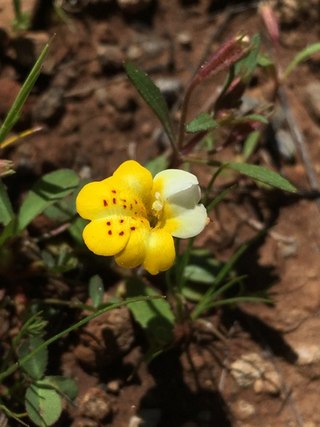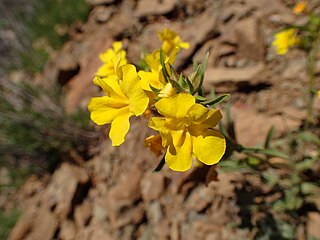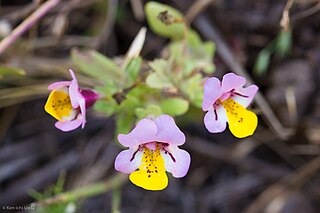
Diplacus douglasii is a species of monkeyflower known by the common names brownies and purple mouse ears. It is native to the mountains and foothills of California and Oregon, where it is often found on serpentine soils. D. douglasii was first described in a published flora by George Bentham, an English botanist who was considered "the premier systematic botanist of the nineteenth century,." It was later described by Asa Gray, the father of North American botany.

Diplacus angustatus is a species of monkeyflower known by the common names purplelip pansy monkeyflower and narrowleaf pansy monkeyflower.

Erythranthe bicolor, the yellow and white monkeyflower, is a species of flowering plant in the lopseed family (Phrymaceae). It is endemic to California, United States. It was formerly known as Mimulus bicolor.

Diplacus bigelovii is a species of monkeyflower known by the common name Bigelow's monkeyflower. It is native to the southwestern United States, where it grows in desert and slope habitats. It was formerly known as Mimulus bigelovii.

Diplacus brevipes is a species of monkeyflower known by the common name widethroat yellow monkeyflower. It was formerly known as Mimulus brevipes.

Diplacus clevelandii is an uncommon species of monkeyflower known by the common name Cleveland's bush monkeyflower. It was formerly known as Mimulus clevelandii.

Diplacus fremontii is a species of monkeyflower known by the common name Frémont's monkeyflower. It is native to California and Baja California, where it grows in mountain and desert habitat, especially moist or disturbed areas. It was formerly known as Mimulus fremontii.

Diplacus jepsonii, formerly classified as Mimulus nanus var. jepsonii, is a species of monkeyflower known by the common name Jepson's monkeyflower.

Diplacus johnstonii is a species of monkeyflower known by the common name Johnston's monkeyflower.

Diplacus layneae is a species of monkeyflower known by the common name Layne's monkeyflower. It is an annual herb that is endemic to California.

Diplacus leptaleus is a species of monkeyflower known by the common name slender monkeyflower.

Diplacus mephiticus is a species of monkeyflower known by the common names skunky monkeyflower and foul odor monkeyflower. It was formerly known as Mimulus mephiticus.

Diplacus nanus is a species of monkeyflower known by the common name dwarf purple monkeyflower. It is native to California and the Northwestern United States to Montana. It grows in moist habitat, often in bare or disturbed soils. It was formerly known as Mimulus nanus.

Diplacus pictus is a species of monkeyflower known by the common name calico monkeyflower.

Diplacus pulchellus is an uncommon species of monkeyflower known by the common name yellowlip pansy monkeyflower. It was formerly known as Mimulus pulchellus.

Diplacus rattanii is a species of monkeyflower known by the common name Rattan's monkeyflower.

Diplacus torreyi is a species of monkeyflower known by the common name Torrey's monkeyflower.

Diplacus tricolor is a species of monkeyflower known by the common name tricolor monkeyflower. It is native to Oregon and California. It grows in seasonally wet habitats such as meadows and vernal pools, including those in the San Joaquin Valley and near north coast oak woodlands. It was formerly known as Mimulus tricolor.

Diplacus viscidus is a species of monkeyflower known by the common name sticky monkeyflower.

Diplacus is a genus of flowering plants in the family Phrymaceae, which was traditionally placed in family Scrophulariaceae. It includes 49 species native to the western United States and northwestern Mexico. Most prefer dry and rocky areas.



















